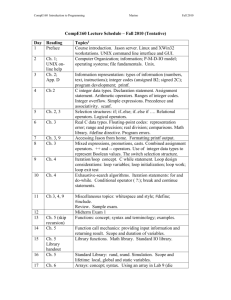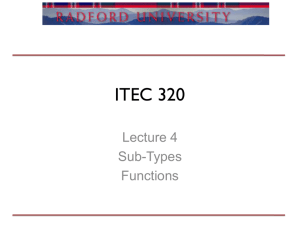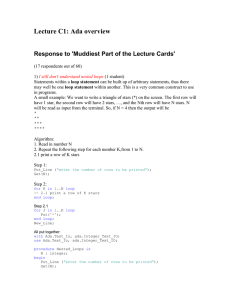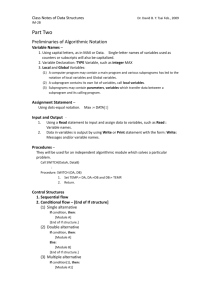Introduction to Computers and Programming So far … • Data structures
advertisement
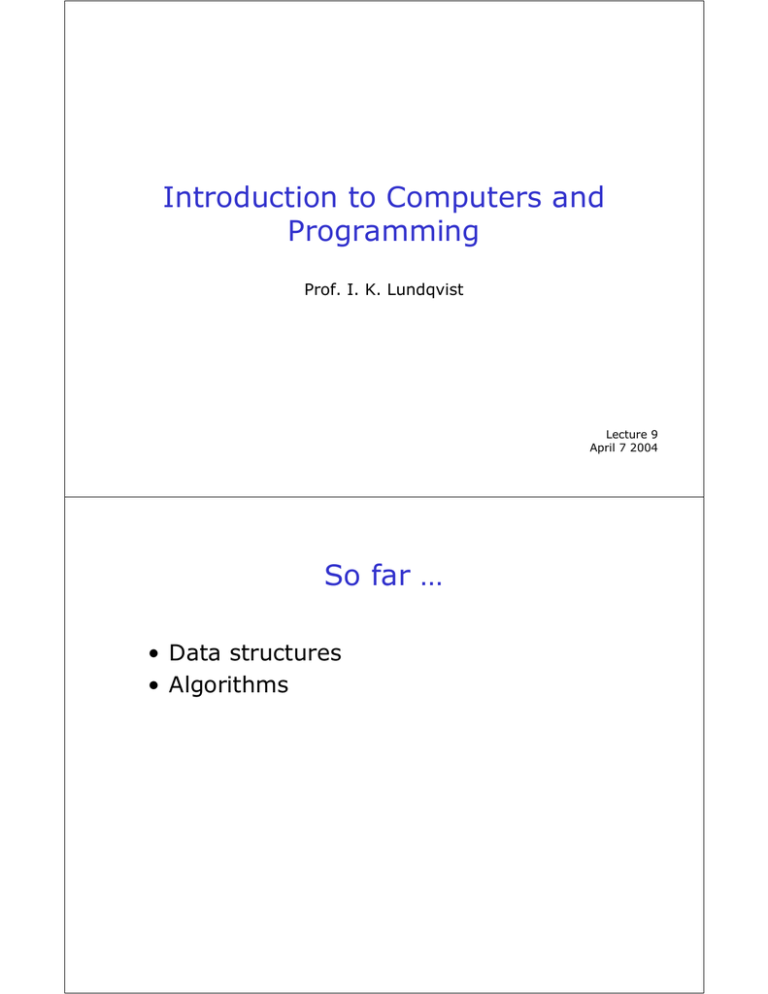
Introduction to Computers and Programming Prof. I. K. Lundqvist Lecture 9 April 7 2004 So far … • Data structures • Algorithms Complexity Analysis “Just “Just how how good good is is my my algorithm?” algorithm?” Best case vs. worst case Storage vs. Computation time Computing the computation time Big-O notation Time (seconds) • • • • 60 50 40 30 20 10 0 O(C) O(n2) 1 2 3 4 5 3 In-class Exercise • Write a procedure that reads an integer N and calculates the sum of all integers 1..N 4 Code Comparison • How many have a solution that runs in linear time? with Ada.Integer_Text_Io, Ada.Text_Io; use Ada.Integer_Text_Io, Ada.Text_Io; procedure CalcSum is N : Integer; Total_Sum : Integer; begin Put_Line("Enter an Integer: "); Get(N); Total_Sum := 0; for I in 1..N loop Total_Sum := Total_Sum + I; end loop; Put(Total_Sum); end; 5 Code Comparison • How many have a solution that runs in N*(N+1) constant time? 2 with Ada.Integer_Text_Io, Ada.Text_Io; use Ada.Integer_Text_Io, Ada.Text_Io; procedure Calcsum is N : Integer; Total_Sum : Integer; begin Put_Line("Enter an Integer: "); Get(N); Total_Sum := 0; Total_Sum := (N * (N + 1)) / 2; Put(Total_Sum); end; 6 Complexity Analysis • Complexity: rate at which storage or time grows as a function of the problem size – Growth depends on compiler, machine, … • Asymptotic analysis: describes the inherent complexity of a program, independent of machine and compiler – Idea: as problem size grows, the complexity can be described as a simple proportionality to some known function. 7 Common Notations for Big-O • O(1) constant time or space • O(N) • O(NM) • O(MN) • O(log N) Or a combination of these 8 O(1) • Constant time or space, independently of what input we give to the algorithm • Examples: • Access element in an array • Retrieve the first element in a list •… 9 O(N) • We have to search through all existing elements to find that the element we are looking for does not exist • Examples: • Searching for element in a list that does not exist • Searching through a Binary Tree of size N where a value does not exist 10 O(log N) • Example, a full balanced Binary Search Tree • Can eliminate half of the BST every time the search • Any algorithm that eliminates a large portion of the data set at each iteration is generalized into O(log N) 11 Binary Search 1 2 3 4 5 6 7 8 9 10 11 12 13 14 15 16 10 11 14 17 21 33 55 57 62 71 87 89 91 93 95 97 How many elements are examined in worst case? 12 Binary Search Input: Array to search, element to search for Output: Index if element found, -1 otherwise Algorithm: Set Return_Index to -1; Set Current_Index to (UB + LB) /2 Loop if the LB > UB Exit; if Input_Array(Current_Index) = element Return_Index := Current_Index Exit; if Input_Array(Current_Index) < element LB := Current_Index +1 else UB := Current_Index - 1 Return Return_Index 13 O(NM) N := 1; • while Ex? N > 0 loop Put("How many repetions? "); Get(N); X := 0; for I1 in 1..N loop for I2 in 1..N loop for I3 in 1..N loop for I4 in 1..N loop for I5 in 1..N loop X := X + 1; end loop; end loop; end loop; end loop; end loop; Put(X); New_Line; end loop; 14 O(MN) • Example: Fibonacci algorithm – f(0) = 1 – f(1) = 1 – f(n+2) = f(n) + f(n+1) ∀ n≥0 2N calculations 15 Big-O • O(N+M) – Sequential and unrelated tasks – Ex: to find the smallest N1 and largest N2 number in a list and generate a new list of all the numbers in between N1 and N2 • O(N*M) – Nesting of tasks – Ex: initializing a n-by-m matrix 16 Asymptotic Analysis: Big-O • Mathematical concept that expresses “how good” or “how bad” an algorithm is Definition:T(n) = O(f(n)) – “T of n is in Big-Oh of f of n” iff there are constants c and n0 such that: T(n) ≤ cf(n) for all n ≥ n0 Usage: The algorithm is in O(n2) in [best, average, worst] case. Meaning: For all data sets big enough (i.e., n>n0), the algorithm always executes in less than cf(n) steps in [best, average, worst] case. Big-O is said to describe an “upper bound” on the complexity. 17 Big-O Examples Finding value X in an array (average cost). T(n) = csn/2. T(n) = O(f(n)) iff T(n) ≤ cf(n) for all n ≥ n0 For all values of n > 1, csn/2 <= csn. Therefore, by the definition, T(n) is in O(n) for n0 = 1 and c = cs. 18 Big-O Example T(n) = c1n2 + c2n in average case. T(n) = O(f(n)) iff T(n) ≤ cf(n) for all n ≥ n0 c1n2 + c2n <= c1n2 + c2n2 <= (c1 + c2)n2 for all n > 1. T(n) <= cn2 for c = c1 + c2 and n0 = 1. Therefore, T(n) is in O(n2) by the definition 19 Big-O Simplifications O(2*N) Same as O(N) O(5*3N) Same as O(3N) O(4711) Same as O(1) O(N+1) Reduces to O(N) O(N2+logN) Reduces to O(N2) O(N*logN+2N+50000) Reduces to O(2N) 20 Big-O Simplifications O(N+P+Q) Same as O(5*N3 + 7N+ 2P+Q*R) Reduces to O(5*N3+2P+Q*R) O(N2logP+N) Same as O(N2logP+N) O(N*M+N2) Same as O(N*M+N2) O(N+P+Q) 21 Faster Computer or Algorithm? The old computer processes 10,000 instructions per hour What happens when we buy a computer 10 times faster? T(n) n n’ n’/n 10n 1,000 10,000 10 20n 500 5,000 10 5n log n 250 1,842 7.37 2n2 70 223 3.16 2n 13 16 ----22
